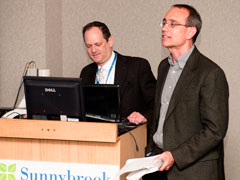Summit Touts Translation
By Jim Oldfield
Sunnybrook Research Institute (SRI) welcomed researchers, clinicians and industry partners from around the world to Sunnybrook's Jenkin auditorium on June 10, 2009, for an all-day workshop on chronic total occlusions (CTOs).
The Second Canadian CTO Summit: Translating Science to the Clinic focused on how research can achieve better results for patients with CTOs, which are total peripheral or coronary arterial blockages lasting six weeks or longer.
About 30% of patients with coronary artery disease (in which the heart's major blood vessels are damaged or diseased) and 50% of those with peripheral arterial disease (a circulatory problem in which narrowed arteries reduce blood flow to the limbs) have at least one CTO.
Introducing the day was Dr. Graham Wright, director of the Schulich heart research program at SRI, a professor at the University of Toronto, and a co-lead investigator of the Canadian Institutes of Health Research (CIHR) team in occlusive vascular disease. Afterwards, he spoke to the day's theme: "The first summit was really setting the stage, and this one has taken it to the next level. We're seeing the science move toward the clinic, with much more dialogue between the clinical work and the scientific work."
The event featured talks organized into three sessions: characterization of CTOs, aimed at understanding their pathophysiology and developing preclinical models to study them; determination of whom to treat, based on evidence of which patients benefit most from treatment; and new treatments and imaging strategies for CTOs, including innovations in basic physics and biology for percutaneous intervention (PCI).
Percutaneous intervention is a minimally invasive procedure in which a cardiologist places small catheters and guidewires into an artery in the leg or wrist through a skin puncture, and directs them into the heart arteries with X-ray imaging. A miniature guidewire is then passed through the blockage in the heart artery. Insertion of a balloon angioplasty catheter or a stent then reopens the clogged vessel and restores blood flow.
Peripheral CTOs can result in leg pain with walking, inadequate blood flow to the limbs and, in severe cases, amputation. Restoring blood flow through PCI avoids these outcomes; for coronary CTOs, moreover, it improves chest pain, and the heart's ability to function, and likely extends life.
Currently, only about 10% of patients with coronary CTOs are treated by PCI, owing to difficulty in passing the guidewire; most receive bypass surgery or are left with medical management that may not be effective. New imaging techniques, however—as evidenced in several presentations at this year's summit—are driving a surge of interest in PCI as an increasingly viable therapy.
On the biology side, Dr. Bradley Strauss, a senior scientist at SRI, co-lead investigator of the CIHR team, and a professor at U of T, recently showed that an enzyme called collagenase can soften the dense lesions in CTOs, enabling PCI where it was previously difficult or impossible. Strauss presented these preclinical findings at the summit, and outlined plans for a "first-in-man" trial of his promising new technique.
"I was very impressed with today's meeting," said Strauss. "I learned a lot, and I also was very proud of what my colleagues have done. That's why I love being part of this team—the breadth and depth of talent."
PDF / View full media release »





